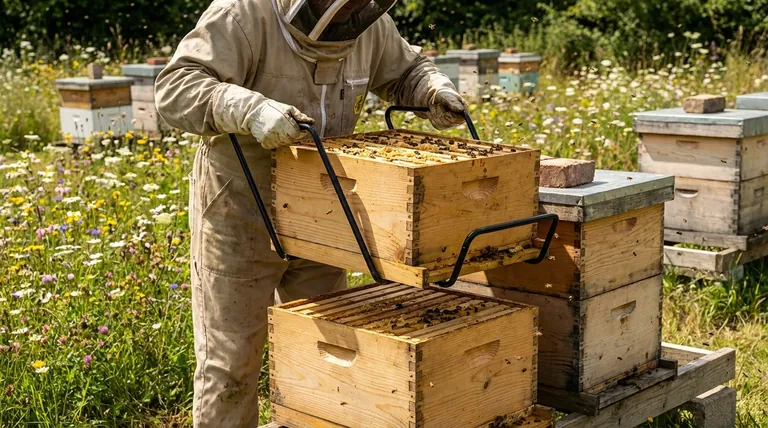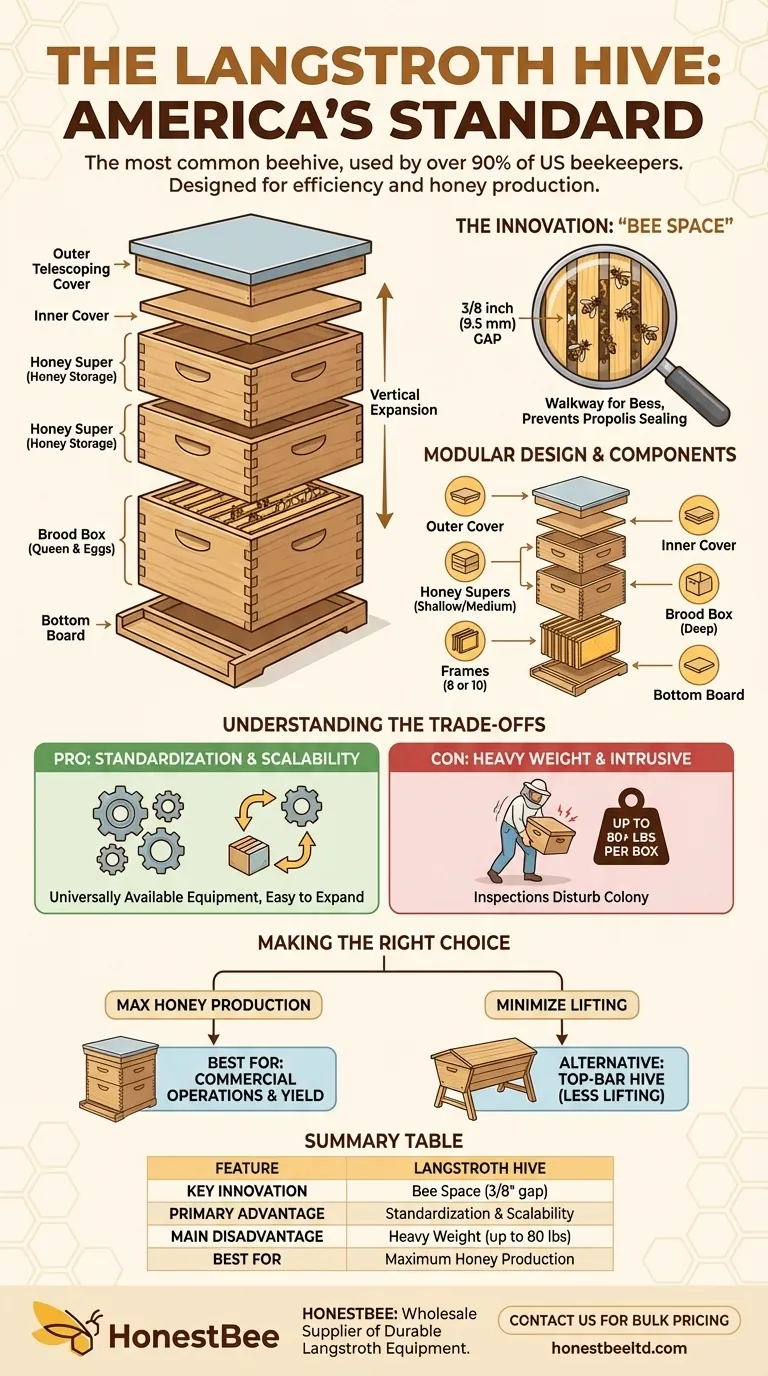Unquestionably, the most common beehive used in the United States is the Langstroth hive. It is the dominant choice for over 90% of American beekeepers, from commercial operators to backyard hobbyists. Its design consists of simple, rectangular boxes, called supers, which are stacked vertically and house a series of removable frames.
The Langstroth hive's dominance isn't just about its boxy shape; it's about a revolutionary principle called "bee space." This specific spacing allows for movable frames, which transformed beekeeping from a destructive harvest into a sustainable practice of colony management.

The Principle Behind the Standard
To understand why the Langstroth is so prevalent, you must first understand the problem it solved. Early beekeeping often involved destroying the colony's comb to harvest honey. The Langstroth hive changed everything by respecting the bees' natural behavior.
The Innovation of "Bee Space"
The core genius of the Langstroth design is its precise spacing. Reverend Lorenzo Langstroth discovered that if he left a gap of approximately 3/8 of an inch (9.5 mm) between frames and the hive walls, bees would not build comb in it or seal it with propolis.
This "bee space" acts as a perfect walkway for the bees. More importantly, it allows a beekeeper to easily slide frames in and out without breaking comb or angering the colony.
A Modular, Vertical Design
The Langstroth hive is built on a modular system. It starts with a base, a brood box where the queen lays her eggs, and a cover.
As the colony grows and needs more space to store honey, the beekeeper simply adds more boxes, known as honey supers, on top. This vertical expansion makes the hive highly scalable for honey production.
The Key Components
A standard Langstroth setup consists of a few interchangeable parts: a bottom board, one or more deep hive bodies for the brood, several smaller "supers" for honey, and inner and outer covers. Inside each box hang 8 or 10 frames where bees build their comb.
Understanding the Trade-offs
While the Langstroth is the standard, it is not the only option. Its popularity comes with clear advantages but also notable disadvantages that are critical to consider.
Pro: Unmatched Standardization
Because the Langstroth is the industry standard, equipment is universally available and interchangeable. Whether you need a new frame, a replacement box, or a specialized tool, you can find it easily and affordably from countless suppliers. This makes starting and expanding your operation incredibly straightforward.
Con: The Weight Factor
The biggest drawback of the Langstroth system is its weight. A single deep hive body full of brood, pollen, and honey can weigh over 80 pounds. A honey super ready for harvest can easily weigh 50-60 pounds. This makes inspections and harvesting a significant physical challenge.
Con: An Intrusive Inspection Process
Properly managing a Langstroth hive requires periodically inspecting the bottom brood box. This means you must lift off every heavy honey super stacked on top, which can be disruptive to the colony and strenuous for the beekeeper.
Making the Right Choice for Your Goal
Selecting a hive type depends entirely on your personal beekeeping philosophy and physical capabilities. The "best" hive is the one that aligns with your objectives.
- If your primary focus is maximum honey production and easy access to equipment: The Langstroth hive is the proven, industry-standard choice for its efficiency and scalability.
- If your primary focus is minimizing heavy lifting and a more natural approach: Consider exploring alternatives like the horizontal Top-Bar hive, which eliminates the need to lift heavy boxes.
Understanding the principles behind each hive design is the first step toward becoming a successful and responsible beekeeper.
Summary Table:
| Feature | Langstroth Hive |
|---|---|
| Key Innovation | Bee Space (3/8 inch gap) |
| Primary Advantage | Standardization & Scalability |
| Main Disadvantage | Heavy Weight (up to 80 lbs per box) |
| Best For | Maximum honey production & commercial operations |
| Alternative | Top-Bar hive for less lifting |
Ready to scale your beekeeping operation with the industry standard?
As a leading wholesale supplier to commercial apiaries and distributors, HONESTBEE provides the durable, high-quality Langstroth equipment you need for maximum efficiency and honey yield. Our bulk-focused operations ensure you get the reliable supplies to support your growth.
Contact our expert team today for wholesale pricing and to discuss your specific equipment needs.
Visual Guide

Related Products
- Ergonomic Two Person Foldable Hive Lifter
- Professional Grade Foldable Beehive Handles
- HONESTBEE Professional Hive Top Bee Feeder Feeding Solution
- Professional Drop-Style Hive Handles for Beekeeping
- Professional Galvanized Hive Strap with Secure Locking Buckle for Beekeeping
People Also Ask
- How do you lift a beehive? A Guide to Safe & Efficient Hive Relocation
- What factors determine the size of a hive? Master the 3 Key Elements for Healthy Colonies
- What is the recommended method for pushing multiple frames back into place? Master the 2-4 Frame Technique for Bee Safety
- What is the spur hive tool used for? The Essential Multi-Tool for Every Beekeeper
- What is a beekeeper tool? The Essential Hive Management Lever for Apiaries



















